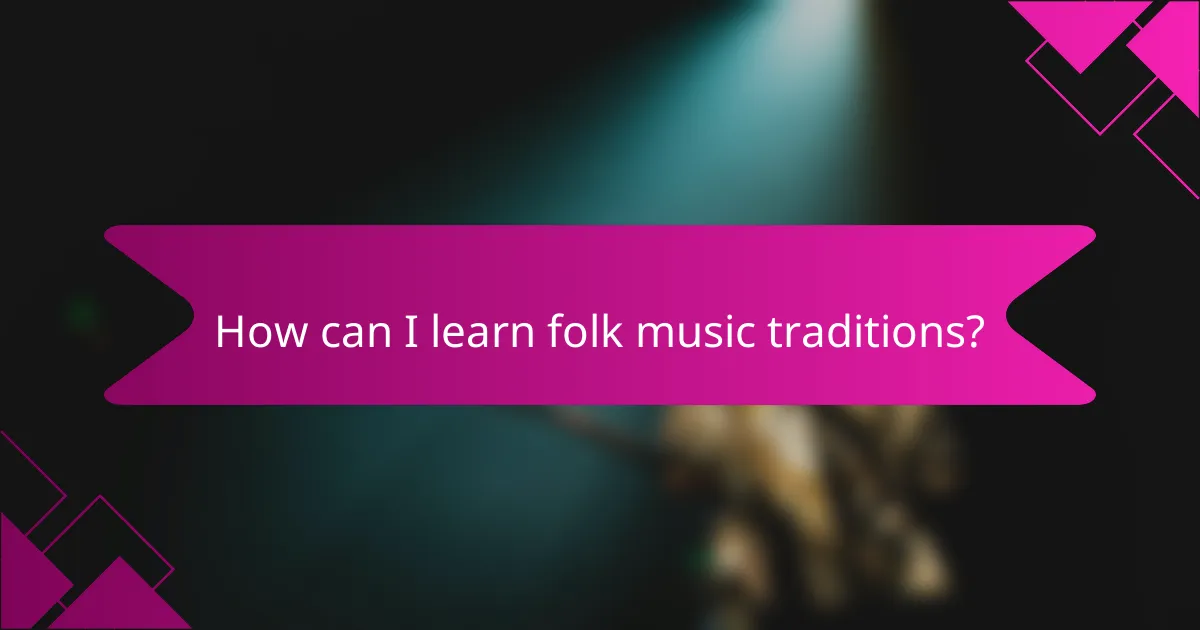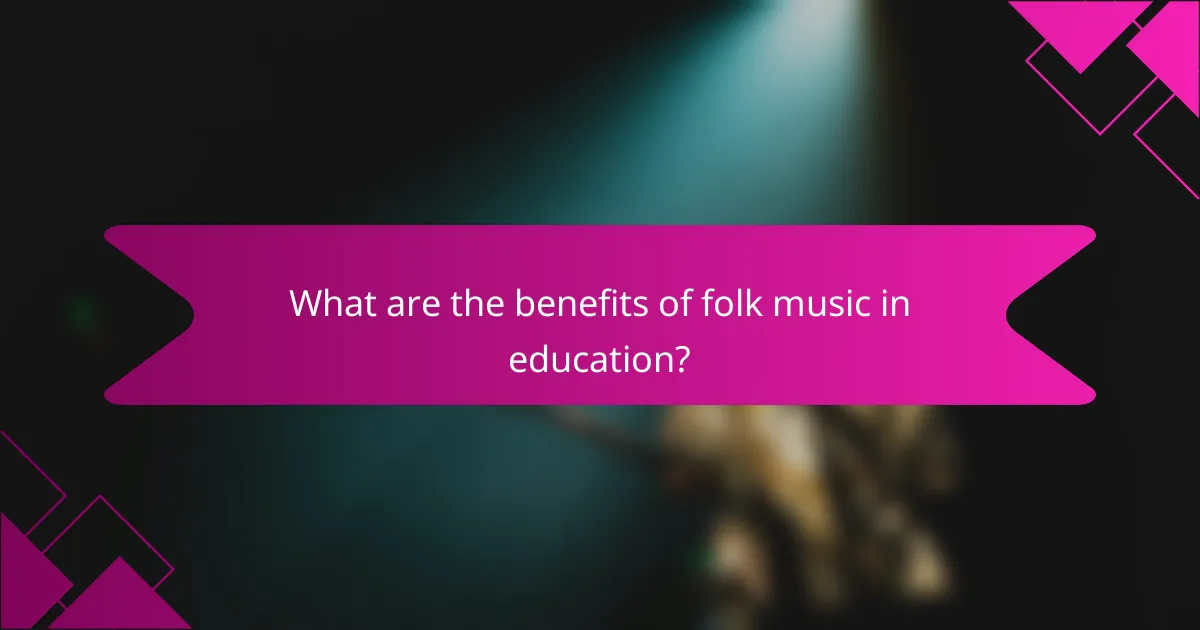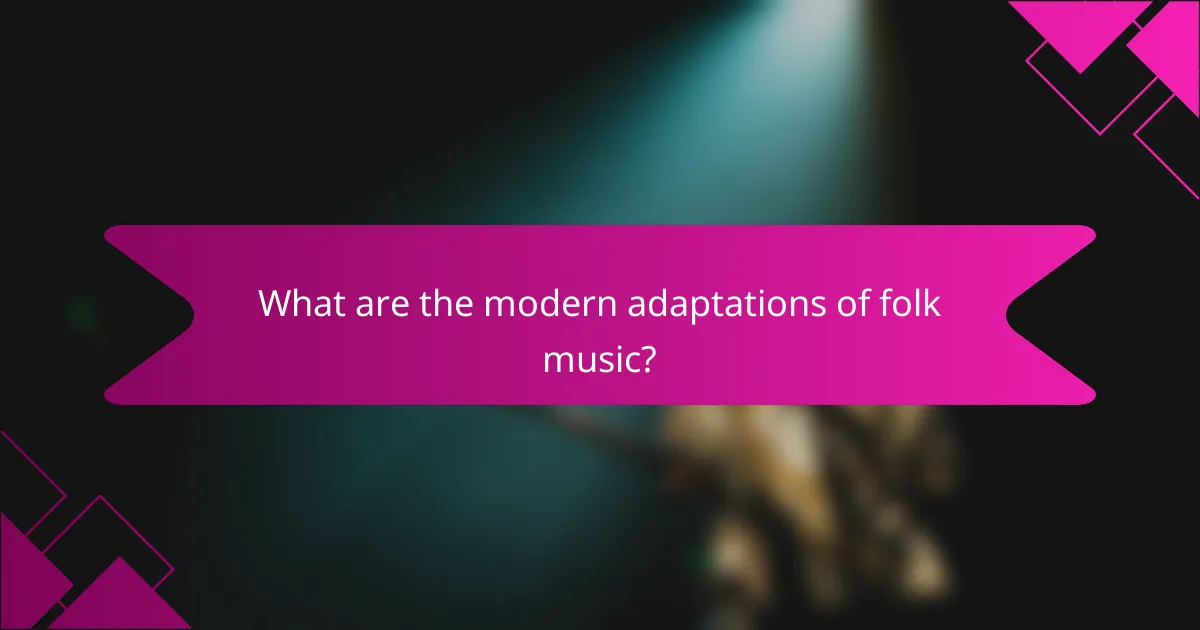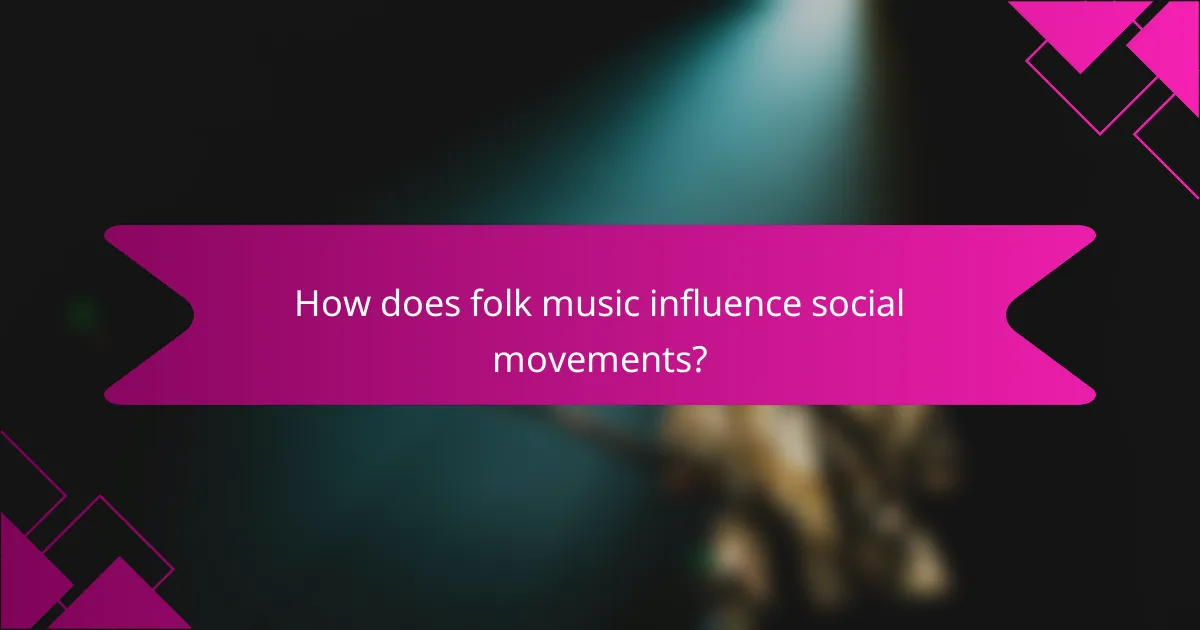Folk music serves as a vital conduit for preserving cultural heritage, weaving together the stories, values, and traditions of diverse communities. With the use of acoustic instruments like the guitar, banjo, and fiddle, it not only delivers captivating melodies but also connects listeners to the rich historical narratives and emotions embedded within each song.

How does folk music preserve cultural heritage?
Folk music plays a vital role in preserving cultural heritage by encapsulating the stories, values, and traditions of communities. Through its melodies and lyrics, folk music transmits historical narratives and social norms across generations, ensuring that cultural identities remain vibrant and relevant.
Storytelling through song
Folk music serves as a powerful medium for storytelling, often conveying tales of love, struggle, and community life. Each song can reflect the experiences of a particular culture, allowing listeners to connect with the emotions and events that shape their heritage.
For example, ballads often recount historical events or personal stories, providing insight into the lives of those who came before. This narrative aspect not only entertains but also educates listeners about their cultural roots.
Community bonding and identity
Folk music fosters community bonding by bringing people together during performances, festivals, and gatherings. Shared musical experiences create a sense of belonging and reinforce cultural identity among participants.
In many cultures, communal singing or playing traditional instruments during celebrations strengthens social ties and promotes collective memory. This shared engagement helps maintain cultural practices and encourages intergenerational connections.
Historical context and traditions
Folk music is deeply intertwined with historical context, often reflecting the social and political climates of its time. The themes and styles of folk songs can reveal much about the struggles and triumphs faced by communities throughout history.
Traditions in folk music, such as specific instruments or regional styles, often vary widely across different cultures. For instance, the use of the banjo in American folk music or the accordion in European folk traditions highlights how local resources and influences shape musical expression.

What are the key acoustic instruments in folk music?
The key acoustic instruments in folk music include the guitar, banjo, and fiddle, each playing a significant role in the storytelling tradition and cultural heritage of various communities. These instruments not only provide melody and rhythm but also connect listeners to the history and emotions embedded in the songs.
Guitar as a primary instrument
The guitar is often considered the backbone of folk music, providing both harmony and rhythm. Its versatility allows for various playing styles, from fingerpicking to strumming, making it suitable for different folk traditions worldwide.
In many cultures, the guitar serves as a primary instrument for solo performances and group settings alike. For instance, in American folk, it often accompanies singers and storytellers, enhancing the lyrical narrative.
Banjo’s role in American folk
The banjo is a distinctive instrument in American folk music, known for its bright, twangy sound. It originated from African musical traditions and became a staple in Appalachian and bluegrass music, contributing to the genre’s unique identity.
Typically played with fingerpicks, the banjo adds a lively rhythm to folk songs. Its role is particularly prominent in storytelling, where its upbeat tempo can evoke feelings of joy and nostalgia.
Fiddle in various folk traditions
The fiddle, essentially a violin played in a folk style, is integral to many cultural folk traditions, including Irish, Scottish, and American music. Its expressive capabilities allow for a wide range of emotions, from lively jigs to somber ballads.
In folk ensembles, the fiddle often leads melodies and engages in call-and-response patterns with other instruments. This interaction enhances the storytelling aspect of folk music, making it a vital component of communal gatherings and celebrations.

How can I learn folk music traditions?
Learning folk music traditions involves engaging with various resources, including online courses, workshops, and self-study materials. These avenues provide practical skills and cultural insights that enhance your understanding and appreciation of folk music.
Online courses on folk music
Online courses offer a flexible way to learn folk music traditions at your own pace. Platforms like Coursera, Udemy, and specialized music schools often feature courses focused on specific genres, instruments, or cultural contexts.
When selecting a course, consider factors such as instructor expertise, course reviews, and the depth of content. Look for options that include video lessons, interactive assignments, and community forums for discussion.
Workshops and community events
Participating in workshops and community events is an excellent way to immerse yourself in folk music traditions. Local music schools, cultural centers, and festivals frequently host hands-on workshops where you can learn from experienced musicians and connect with fellow enthusiasts.
Check local listings or community boards for upcoming events. Engaging in these activities not only enhances your skills but also helps you understand the cultural significance of the music.
Books and resources for self-study
Books and self-study resources can provide a solid foundation in folk music traditions. Look for instructional books that cover techniques for specific instruments, as well as texts that explore the history and cultural context of folk music.
Additionally, consider online resources such as blogs, instructional videos, and forums where you can find tips and share experiences. A combination of reading and practical application will deepen your understanding and proficiency.

What are the benefits of folk music in education?
Folk music offers numerous benefits in education, enhancing learning through creativity, cultural understanding, and musical skill development. By integrating folk music into educational settings, students can engage more deeply with their heritage and express themselves effectively.
Enhancing creativity and expression
Folk music encourages students to explore their creativity and express their emotions. Through songwriting and performance, learners can develop their unique voices and storytelling abilities. Activities such as composing new verses to traditional songs or creating original pieces based on folk themes can stimulate imaginative thinking.
Incorporating folk music into lessons can also lead to collaborative projects, where students work together to create and perform. This teamwork fosters a sense of community and shared expression, enhancing their overall educational experience.
Promoting cultural awareness
Folk music serves as a powerful tool for promoting cultural awareness among students. By studying the origins and meanings of various folk songs, learners gain insights into the traditions and values of different communities. This understanding fosters respect and appreciation for cultural diversity.
Educators can introduce folk music from various regions, allowing students to explore the stories behind the songs. This exploration can include discussions about historical contexts, social issues, and the evolution of cultural practices, enriching students’ global perspectives.
Developing musical skills
Engaging with folk music helps students develop essential musical skills, including rhythm, melody, and harmony. Learning to play traditional instruments, such as the guitar, banjo, or fiddle, can enhance their technical abilities and musical ear. Folk music often emphasizes simple chord progressions, making it accessible for beginners.
Participating in folk music ensembles or community groups can further enhance these skills through practical experience. Students can learn to collaborate musically, improving their listening skills and ability to perform in a group setting, which is invaluable for their overall musical education.

What are the modern adaptations of folk music?
Modern adaptations of folk music blend traditional elements with contemporary styles, creating a diverse sound that resonates with new audiences. These adaptations often incorporate various genres, technologies, and platforms to enhance the storytelling tradition inherent in folk music.
Fusion with contemporary genres
Folk music has increasingly fused with genres like rock, pop, and electronic music, resulting in innovative sounds that attract a broader audience. Artists often incorporate traditional acoustic instruments, such as the guitar and banjo, alongside modern production techniques to create a unique blend.
For example, bands like Mumford & Sons and The Lumineers have successfully merged folk roots with modern influences, leading to chart-topping hits. This fusion not only revitalizes folk music but also introduces its storytelling elements to listeners who may not typically engage with traditional forms.
Use in film and media
Folk music plays a significant role in film and media, often used to evoke emotions and enhance storytelling. Soundtracks featuring folk-inspired compositions can transport audiences to specific cultural settings, enriching the narrative experience.
Films like “O Brother, Where Art Thou?” and “Inside Llewyn Davis” showcase folk music’s ability to connect with viewers on a personal level. These films highlight the cultural heritage embedded in folk traditions, making them accessible to a wider audience through cinematic storytelling.
Digital platforms for sharing
Digital platforms have revolutionized how folk music is shared and consumed, allowing artists to reach global audiences without traditional barriers. Streaming services like Spotify and YouTube enable musicians to distribute their work widely, while social media platforms facilitate direct engagement with fans.
Moreover, platforms like Bandcamp empower independent artists to sell their music directly to listeners, often retaining a larger share of revenue. This democratization of music distribution encourages the preservation and evolution of folk traditions, as new artists can experiment and innovate within the genre.

How does folk music influence social movements?
Folk music plays a significant role in social movements by serving as a powerful tool for expression and unity. It can convey messages of resistance, hope, and solidarity, often reflecting the struggles and aspirations of communities.
Storytelling Tradition
The storytelling tradition in folk music captures the experiences and narratives of ordinary people, making it relatable and impactful. Songs often recount historical events, social injustices, or personal tales, fostering a sense of shared identity among listeners.
Through storytelling, folk music can raise awareness about social issues, encouraging listeners to reflect on their own experiences and take action. This narrative approach helps to humanize abstract concepts, making them more accessible and emotionally resonant.
Acoustic Instruments
Acoustic instruments are central to folk music, providing an authentic sound that connects audiences to cultural roots. Instruments such as the guitar, banjo, fiddle, and accordion are commonly used, each contributing unique tonal qualities that enhance the storytelling aspect.
The use of acoustic instruments allows for a more intimate and personal performance, which can evoke strong emotions and foster community engagement. This connection is vital in social movements, as it encourages collective participation and solidarity through shared musical experiences.
Cultural Heritage
Folk music is a vital expression of cultural heritage, preserving traditions and histories that might otherwise be forgotten. It reflects the values, struggles, and triumphs of specific communities, serving as a living archive of their collective memory.
By celebrating cultural heritage through folk music, social movements can strengthen community ties and promote a sense of belonging. This cultural pride can empower individuals to advocate for social change, reinforcing the idea that their voices and stories matter in the broader societal context.
